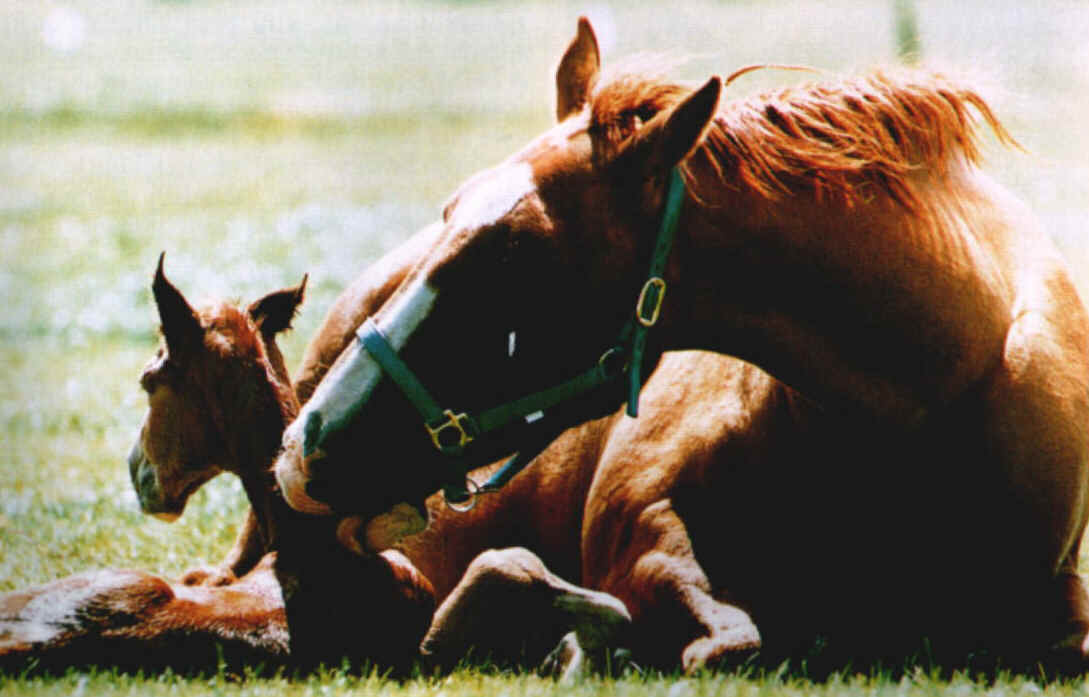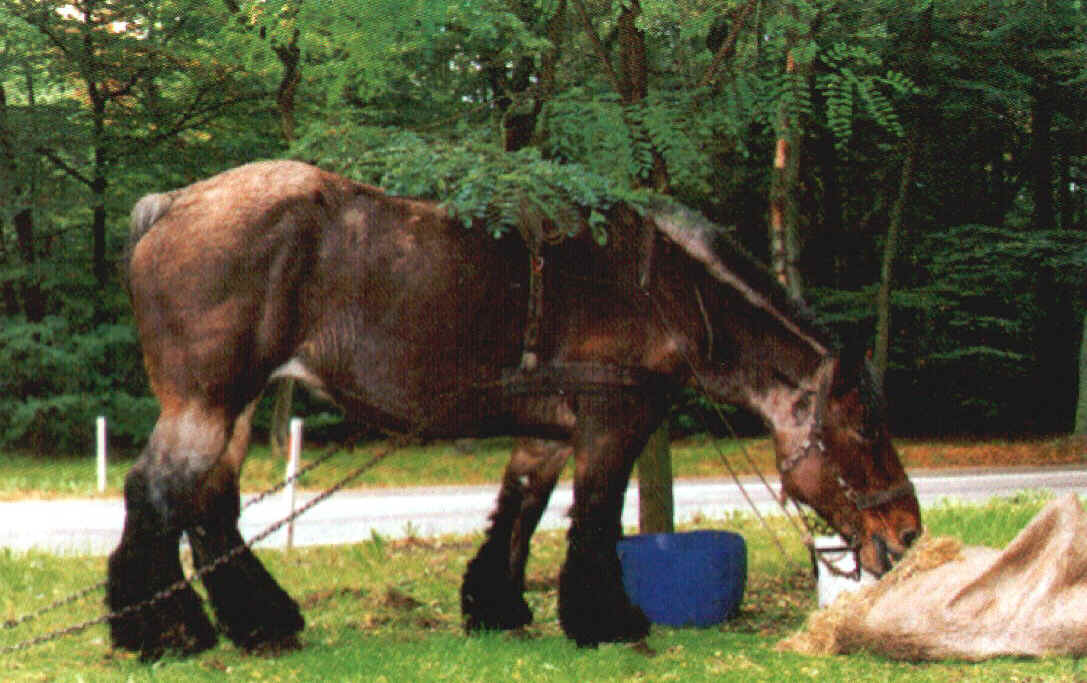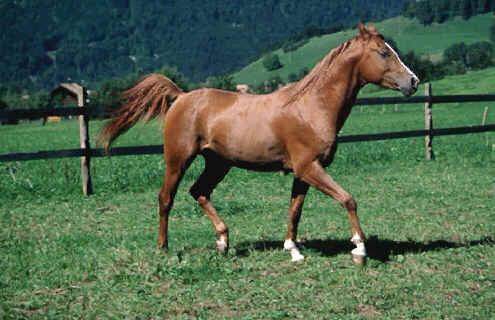



ARABIAN
 Also
called Arab, one of the oldest horse breeds, native to the
Arabian Peninsula. The Arabian was the horse of the Bedouin
people (nomadic Arabs) as early as 3000 to 2500 BC. This ancient,
pure breed is widely regarded as the definition of beauty and
elegance in horses. Acknowledged as the primary ancestor of the
Thoroughbred horse, famed for its speed, strength, and endurance,
the Arabian has influenced the development of almost all modern
horse breeds. An unmatched combination of great stamina, speed, a
solid body, intelligence, longevity, and grace are significant
traits the Arabian has passed on to other breeds. The Arabian has
a lean, fine body. It stands about 147 to 153 cm (about 58 to 60
in, or 14 to 15 hands) high at the withers. (the high part of the
back, located between the shoulder bones). The legs are
well-muscled with broad joints, and the feet are small and tough.
The Arabian has 17 ribs, 5 lumbar vertebrae, and 16 caudal
vertebrae, compared with 18 ribs, 6 lumbar vertebrae, and 18
caudal vertebrae in most horses. This bone structure gives the
Arabian a comparatively short back that is slightly concave. It
also has a high, banner-like carriage of its tail. A
distinguishing feature of the Arabian's neck is the mitbah, the
angle that gives the neck its characteristic arch and the head a
wide range of motion. Breeders often emphasize the mitbah by
shaving the first 15 to 20 cm (6 to 8 in) of the mane. The
wedge-shaped head tapers to a small, soft muzzle. The face has a
noticeable dished, or concave, profile. The jaws are round and
wide set, and the forehead is high and rounded. The Arabian's
dark eyes are remarkable: large and wide, the eyes are more
oval-shaped in the Arabian than in other breeds. The Arabian is
chestnut (gold), bay (reddish), gray, or black. Dark skin around
the eyes enhances the horse's dark appearance. Mystery and
mysticism surround the origins of the Arabian. According to an
ancient legend, the Arabian descended from 7 ancestors selected
by King Solomon, ruler of ancient Israel between 961 and 922 BC,
from the 40,000 chariot horses and 12,000 riding horses he owned.
Muslim tradition says the breed descended from the 5 mares of the
prophet Muhammad, the founder of Islam, that were the first of 85
to reach Mecca after the prophet sent them there with news of a
military victory. Breeders today believe that the Arabian
probably descended from the Tarpan, a prehistoric, primitive
horse, and the Caspian, a pony that is the most ancient horse
breed in existence. The Arabian has been bred pure on the Arabian
Peninsula throughout its existence. The bloodlines of this horse
are traced through the descendants of individual mares. For
centuries, Bedouin horsemen kept track of their horses' pedigrees
by word of mouth, tracing them back to at least 2500 BC. Owners
who could write noted a mare's ancestry on a small piece of
parchment and placed it together with small blue beads in a bag,
which then was placed around the mare's neck to ward off evil
spirits. The Arabian was used by Bedouins for both transportation
and as a mount for battle with neighboring peoples.
Traditionally, only mares were ridden into battle. They were
called banat er rih, or daughters of the wind. The Arabian also
played a key role in the spread of Islam. Muhammad declared that
by caring for this horse in life, the faithful would be redeemed
after death. Muslim invasions in the 7th and 8th centuries
introduced the Arabian to North Africa and Southern Europe where
it influenced the development of additional horse breeds.
Military leaders who rode the Arabian into battle include George
Washington and Napoleon. By the 19th century, breeding programs
were well established throughout Europe. Most Arabian horses now
are bred in the United States, Great Britain, and Poland.
Also
called Arab, one of the oldest horse breeds, native to the
Arabian Peninsula. The Arabian was the horse of the Bedouin
people (nomadic Arabs) as early as 3000 to 2500 BC. This ancient,
pure breed is widely regarded as the definition of beauty and
elegance in horses. Acknowledged as the primary ancestor of the
Thoroughbred horse, famed for its speed, strength, and endurance,
the Arabian has influenced the development of almost all modern
horse breeds. An unmatched combination of great stamina, speed, a
solid body, intelligence, longevity, and grace are significant
traits the Arabian has passed on to other breeds. The Arabian has
a lean, fine body. It stands about 147 to 153 cm (about 58 to 60
in, or 14 to 15 hands) high at the withers. (the high part of the
back, located between the shoulder bones). The legs are
well-muscled with broad joints, and the feet are small and tough.
The Arabian has 17 ribs, 5 lumbar vertebrae, and 16 caudal
vertebrae, compared with 18 ribs, 6 lumbar vertebrae, and 18
caudal vertebrae in most horses. This bone structure gives the
Arabian a comparatively short back that is slightly concave. It
also has a high, banner-like carriage of its tail. A
distinguishing feature of the Arabian's neck is the mitbah, the
angle that gives the neck its characteristic arch and the head a
wide range of motion. Breeders often emphasize the mitbah by
shaving the first 15 to 20 cm (6 to 8 in) of the mane. The
wedge-shaped head tapers to a small, soft muzzle. The face has a
noticeable dished, or concave, profile. The jaws are round and
wide set, and the forehead is high and rounded. The Arabian's
dark eyes are remarkable: large and wide, the eyes are more
oval-shaped in the Arabian than in other breeds. The Arabian is
chestnut (gold), bay (reddish), gray, or black. Dark skin around
the eyes enhances the horse's dark appearance. Mystery and
mysticism surround the origins of the Arabian. According to an
ancient legend, the Arabian descended from 7 ancestors selected
by King Solomon, ruler of ancient Israel between 961 and 922 BC,
from the 40,000 chariot horses and 12,000 riding horses he owned.
Muslim tradition says the breed descended from the 5 mares of the
prophet Muhammad, the founder of Islam, that were the first of 85
to reach Mecca after the prophet sent them there with news of a
military victory. Breeders today believe that the Arabian
probably descended from the Tarpan, a prehistoric, primitive
horse, and the Caspian, a pony that is the most ancient horse
breed in existence. The Arabian has been bred pure on the Arabian
Peninsula throughout its existence. The bloodlines of this horse
are traced through the descendants of individual mares. For
centuries, Bedouin horsemen kept track of their horses' pedigrees
by word of mouth, tracing them back to at least 2500 BC. Owners
who could write noted a mare's ancestry on a small piece of
parchment and placed it together with small blue beads in a bag,
which then was placed around the mare's neck to ward off evil
spirits. The Arabian was used by Bedouins for both transportation
and as a mount for battle with neighboring peoples.
Traditionally, only mares were ridden into battle. They were
called banat er rih, or daughters of the wind. The Arabian also
played a key role in the spread of Islam. Muhammad declared that
by caring for this horse in life, the faithful would be redeemed
after death. Muslim invasions in the 7th and 8th centuries
introduced the Arabian to North Africa and Southern Europe where
it influenced the development of additional horse breeds.
Military leaders who rode the Arabian into battle include George
Washington and Napoleon. By the 19th century, breeding programs
were well established throughout Europe. Most Arabian horses now
are bred in the United States, Great Britain, and Poland.
Akhal Teké - Andalusian - Appaloosa - Arabian - Ass - Australian Stock Horse - Bashkir Belgium Heavy Draft horse - Cleveland Bay - Clydesdale - Dutch Warmblood - Gelderlander - Hackney - Holsteiner - Paard (algemeen) - Irish Draught - Lippizaner - Missouri Fox Trotter - Morgan Horse - Mule - Mustang - Oldenburger - Palomino - Percheron - Peruvian Paso - Pinto - Quarter Horse - Selle Francais - Standardbred - Tarpan - Tennessee Walker - Trakehner - Ungulate (onevenhoevigen) - Zebra -